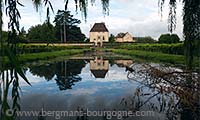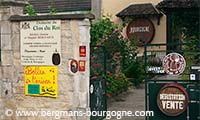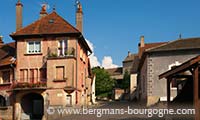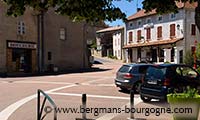
ne has to love the village name. It comes from Latin – Muris Saltus (Rat's jump). True or not, but it makes a good story. Meursault is one of the larger villages along the Cote. The village square - Place de l'Hôtel de ville – is dominated by the 57 metre/187 feet tall beautiful Gothic church, the Eglise St Nicolas which dates back to the 15th century, and the Hôtel de ville from 1337, once a fortress, now the town hall. On the July 14th festivities its façade is used as backdrop for the impressive fireworks.
In 1480 the old church was partially burned. The Abbey of Cluny had it rebuilt and a bell tower was added. During the tenth century the church had been abandoned for periods and it was eventually included in the fiefdom. In 1094 the church was donated to Cluny by the local seigneur at the Castel de Meursault, Frogier. By the end of the 1830's the church was in need of enlargement and restoration. Tenders were invited, Fleurot ainé in Auxey got the contract and the church was reinaugurated on September 25, 1843.
 Meursault offers a range of shops – two bakers', two florists', a wine shop, a tabac, a clothing shop and a small supermarché Casino. The wine shop, Cave des Vieilles Vignes, represents some 65 growers along the Côte with a total of 450 wines. The prices are the same as at the domaines and it is open seven days a week. A great place.
Meursault offers a range of shops – two bakers', two florists', a wine shop, a tabac, a clothing shop and a small supermarché Casino. The wine shop, Cave des Vieilles Vignes, represents some 65 growers along the Côte with a total of 450 wines. The prices are the same as at the domaines and it is open seven days a week. A great place.
My favourite restaurant here, leaning towards the rustic, is Le Bouchon. As the name suggests this is a Lyon-style bistrot, but with a regional touch. The set menus are good value for money and wine is offered by the glass.
For anyone wanting to taste wines Meursault offers several opportunities. Whenever I'm in the village I try to pay both Domaine Matrot and Patrick Javillier a visit. While Matrot requires an appointment Javillier has a tasting cellar down by the Place de l'Europe. Javillier's tasting cellar Cave Saint-Nicolas is open from end of March to end of November, Friday to Monday night and holidays, closed Sunday afternoon.
 Meursault is the third largest commune on the Côte d'Or. The majority of the production is white. Red wine only accounts for three-four percent. There are a total of 29 premier crus (Blagny included), but no grand crus. Instead quite a few of the lieu dits on village level have become well known enough for merit being mentioned on the label – for exemple Tillets, Narvaux, Limouzin and Casse-Têtes. Of the premier crus La Goutte d'Or, Le Porusot, Les Genevrières, Les Charmes and Les Perrières are generally considered as the top five in Meursault.
Meursault is the third largest commune on the Côte d'Or. The majority of the production is white. Red wine only accounts for three-four percent. There are a total of 29 premier crus (Blagny included), but no grand crus. Instead quite a few of the lieu dits on village level have become well known enough for merit being mentioned on the label – for exemple Tillets, Narvaux, Limouzin and Casse-Têtes. Of the premier crus La Goutte d'Or, Le Porusot, Les Genevrières, Les Charmes and Les Perrières are generally considered as the top five in Meursault.
When Jean Lavalle published his "Histoire et Statistique de la Vigne et de Grands Vins de la Cote-d'Or" in 1855 he singled out Les Perrières (Dessus and Dessous) as Tête de Cuvée, the top category. In his opinion, after Montrachet itself there wasn't a wine as exquisit as Les Perrières. He placed Les Perrières alongside Batard-Montrachet and Corton blanc, but ahead of Corton-Charlemagne.
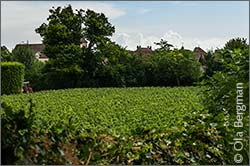 Despite the lack of grand crus many consider Meursault – together with its neighbours Puligy-Montrachet and Chassagne-Montrachet – as being the best commune in the world for producing white wine. But life hasn't always been easy for Meaursault. Over the centuries there have been periods when the village has been out of fashion, with low prices as a result. During the late 18th century Meursault only fetched half the price of Volnay. As recently as in the early 1990's things weren't exactly looking bright either. François Mikulski, who was setting up his own domaine at the time, remembers that prices were the lowest for many years. His intention was to sell the first vintages to négiciants, but after seeing the prices he decided to go back to the bank, borrow some more money for corks and bottles, and bottle all on his own.
Despite the lack of grand crus many consider Meursault – together with its neighbours Puligy-Montrachet and Chassagne-Montrachet – as being the best commune in the world for producing white wine. But life hasn't always been easy for Meaursault. Over the centuries there have been periods when the village has been out of fashion, with low prices as a result. During the late 18th century Meursault only fetched half the price of Volnay. As recently as in the early 1990's things weren't exactly looking bright either. François Mikulski, who was setting up his own domaine at the time, remembers that prices were the lowest for many years. His intention was to sell the first vintages to négiciants, but after seeing the prices he decided to go back to the bank, borrow some more money for corks and bottles, and bottle all on his own.
The Meursault vignoble is divided in two parts, with the village in between. North-east of the village, bordering on Volnay and Monthélie, is the section with the premier crus of Les Cras, Les Santenots. The latter is one of Burgundy´s peculiarities; if planted with pinot it makes Volnay-Santenots and if planted with chardonnay it makes Meursault Premier Cru or Meursault Santenots.
 Southwest of Meursault is a vast area of village vines and premier crus leading down to Puligny-Montrachet. This is where you find the long strip of Les Gouttes d'Or, Les Pruzots, Les Bouchères, Les Genevrières, Les Charmes and Les Perrières that produces lovely Meursaults.
Southwest of Meursault is a vast area of village vines and premier crus leading down to Puligny-Montrachet. This is where you find the long strip of Les Gouttes d'Or, Les Pruzots, Les Bouchères, Les Genevrières, Les Charmes and Les Perrières that produces lovely Meursaults.
– What makes a Meursault a Meursault is a particular style changing with the premier cru and the winemaker, says François Mikulski at Domaine Mikulski. There's no perfect style. For me the best style is minerality. In white wine I like purity, minerality and of course with minerality a certain acidity, just to make the wine exciting. When you have finished your glass you want another one. That means it refreshing, exciting. That's what I like in a wine, even if it is an aligoté or a muscadet.
Down by the Puligny border is another peculiarity. The hamlet of Blagny is surrounded by rules similar to the ones for Volnay-Santenots. So if planted with pinot you get Blagny, but Meursault-Blagny if planted with chardonnay.
Up behind the village, towards Auxey-Duresses, is the Mont Milan (also called Mont Mélian och Mont Meillan in the past). This was once the place for a Gallo-Roman camp, guarding the passage in through the Côte past Auxey-Duresses, La Rochepot and Nolay, and further on to Autun. Strategically located to protect from attacks from the east, from the Saône plains, the camp covered 1,5 hectares. A half-circle shaped wall – 500 metres/1640 feet long, two metres thick and three metres high – together with two parallel moats made life for the invaders even more difficult.
© 2013 Ola Bergman










